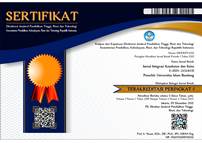Hubungan Indeks Massa Tubuh dengan Kebugaran Fisik pada Petugas Keamanan di Institusi Pendidikan
Abstract
Indeks massa tubuh (IMT) merupakan salah satu indikator status gizi. Indeks massa tubuh menjadi salah satu faktor yang memengaruhi kebugaran fisik. Kelompok pekerjaan petugas keamanan membutuhkan kondisi kebugaran fisik yang baik. Penelitian dilakukan dengan tujuan mengetahui indeks massa tubuh, kebugaran fisik, dan hubungan indeks massa tubuh dengan kebugaran fisik pada petugas keamanan di institusi pendidikan. Penelitian dilakukan dengan desain potong lintang. Penelitian dilakukan pada bulan April 2023. Data diperoleh dari data sekunder institusi dengan jumlah responden sebanyak 81 orang. Data indeks massa tubuh diperoleh dengan membagi berat badan (kg) dengan tinggi badan dikuadratkan (m2). Kebugaran fisik diukur dengan metode Cooper Test. Data dianalisis dengan uji fisher-exact. Hasil penelitian menunjukkan bahwa 52 orang responden memiliki indeks massa tubuh berisiko (64,2%) dan 72 orang responden memiliki kebugaran fisik tidak baik (88,9%). Terdapat hubungan yang bermakna antara indeks massa tubuh dan kebugaran fisik petugas keamanan di institusi pendidikan (p<0,05). Berdasarkan data hasil penelitian tersebut maka disarankan upaya institusi menurunkan indeks massa tubuh dan meningkatkan kebugaran fisik para pertugas keamanan melalui program latihan fisik yang terstruktur selain diimbangi dengan asupan nutrisi yang bergizi dan seimbang.
Abstract
Body mass indeks (BMI) is an indeks of nutritional status. Body mass indeks is one of the factors that influences physical fitness. The security officer job group requires good physical fitness. The research was conducted with the aim of determining body mass indeks, physical fitness, and the relationship between body mass indeks and physical fitness among security officers in educational institutions. The research was conducted with a cross-sectional design. The research was conducted in April 2023. Data was obtained from institutional secondary data with a total of 81 respondents. Body mass indeks data is obtained by dividing body weight (kg) by body height squared (m2). Physical fitness was measured using the Cooper Test method. Data were analyzed using the Fisher-Exact test. The results showed that 52 respondents had a risky body mass indeks (64.2%) and 72 respondents had poor physical fitness (88.9%). There is a significant relationship between body mass indeks and physical fitness of security officers in educational institutions (p<0.05). Based on the research data, tis recommended that institutional efforts be made to reduce body mass indeks and increase the physical fitness of security officers through a structured physical exercise program in addition to being balanced with nutritious and balanced nutritional intake.
Keywords
Full Text:
PDF (Bahasa Indonesia)References
Toumpakari Z, Jago R, Howe LD, Majid HA, Papadaki A, Mohammadi S, dkk. Cardiometabolic risk factors and physical activity patterns maximizing fitness and minimizing fatness variation in Malaysian adolescents: a novel application of reduced rank regression. IJERPH. 2019 Nov 22;16(23):4662.
Garber CE, Blissmer B, Deschenes MR, Franklin BA, Lamonte MJ, Lee IM, dkk. Quantity and quality of exercise for developing and maintaining cardiorespiratory, musculoskeletal, and neuro-motor fitness in apparently healthy adults: guidance for prescribing exercise. Med Scie Sports Exercise. 2011 Jul;43(7):1334– 59.
So WY, Choi DH. Differences in physical fitness and cardiovascular function depend on BMI in Korean men. J Sports Scie Med. 2010;9(1):239–44.
Katzmarzyk PT, Janssen I. The economic costs associated with physical inactivity and obesity in Canada: an update. Cabadian J Applied Physiol. 2004 Aug 28;29(1):90–115.
Lupinacci NS, Rikli RE, Jones CJ, Ross D. Age and physical activity effects on reaction time and digit symbol substitution performance in cognitively active adults. Res Quarterly Exercise Sport. 1993;64(2):144–50.
Lovelace KJ, Manz CC, Alves JC. Work stress and leadership development: the role of self-leadership, shared leadership, physical fitness and flow in managing demands and increasing job control. Human Resource Manag Rev. 2007 Dec;17(4):374–87.
Conn VS, Hafdahl AR, Cooper PS, Brown LM, Lusk SL. Meta-analysis of workplace physical activity interventions. Am J Prevent Med. 2009 Oct;37(4):330–9.
Ganster DC, Rosen CC. Work stress and employee health: a multidisciplinary review. J Manag. 2013 Jul;39(5):1085–122.
Al-Ansari SS, Biddle S, Borodulin K, Buman M, Cardon G, Carty C, dkk. WHO guidelines on physical activity and sedentary behaviour. Vol. 1. Geneva: WHO; 2020. hlm. 1–93.
Riebe D, Ehrman JK, Liguori G, Magal M. ACSM’s guidelines for exercise testing and prescription. Dalam: Nobel M, editor. Philadelphia PA: American College of Sport Medicine; 2018. hlm. 1–651.
Kepala Kepolisian Negara Republik Indonesia. Peraturan Kepala Kepolisian Nomor 4 Tahun 2018 tentang Pembinaan Jasmani di Lingkungan Kepolisian Negara Republik Indonesia; 2018.
Kepala Kepolisian Negara Republik Indonesia. Peraturan Kepolisian Nomor 4 Tahun 2020 tentang Pengamanan Swakarsa. 2020.
Lestari KDP, Wahyuni N, Nugraha MHS, Tianing NW. Hubungan indeks massa tubuh, presentase lemak total tubuh dan aktivitas fisik terhadap tingkat volume oksigen maksimal pada remaja putri di Denpasar Selatan. MIFI. 2020 Jan 15;8(1):49.
So WY, Choi DH. Differences in physical fitness and cardiovascular function depend on BMI in Korean men. J Sports Scie Med. 2010;9(1):239–44.
Nathanael N, Mirtha LT, Mansyur M. Association between waist circumference as central obesity marker and cooper test result in security personnel. J Ecophysiol Occupat Health. 2019 Dec 26;19(3–4):108.
Jago R, Drews KL, McMurray RG, Baranowski T, Galassetti P, Foster GD, dkk. BMI change, fitness change and cardiometabolic risk factors among 8th grade youth. Pediat Exercise Scie. 2013 Feb;25(1):52–68.
Baranowski T, Chen TA, Mendoza JA, O’Connor T, Baranowski J, Jago R. Prospective BMI category change associated with cardiovascular fitness change. Med Scie Sports Exercise. 2013 Feb;45(2):294–8.
Skrede T, Aadland E, Andersen LB, Stavnsbo M, Anderssen SA, Resaland GK, dkk. Does cardiorespiratory fitness moderate the prospective association between physical activity and cardiometabolic risk factors in children? Int J Obes. 2018 May;42(5):1029–38.
Ross R, Goodpaster BH, Koch LG, Sarzynski MA, Kohrt WM, Johannsen NM, dkk. Precision exercise medicine: understanding exercise response variability. Br J Sports Med. 2019 Sep;53(18):1141–53.
DOI: https://doi.org/10.29313/jiks.v6i1.12709
Refbacks
- There are currently no refbacks.
Jurnal Integrasi Kesehatan dan Sains is licensed under a Creative Commons Attribution-NonCommercial-ShareAlike 4.0 International License.







.png)
_(1).png)




















